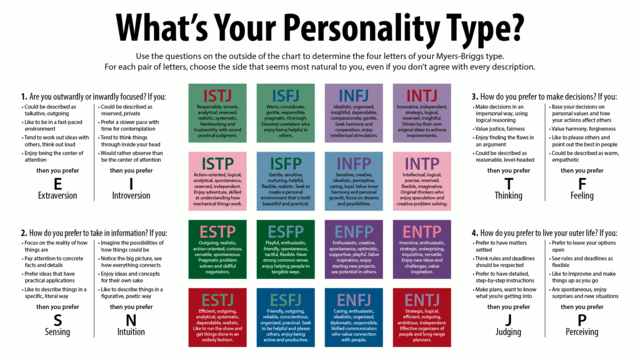Table of Contents
What is the purpose of the Myers-Briggs test?
In the realm of self-discovery and personal development, the Myers-Briggs Type Indicator (MBTI) has emerged as a widely used tool for understanding personality preferences and behavior. Drawing inspiration from the insightful perspectives shared on HiravShah.com, we embark on an in-depth exploration of the Myers-Briggs Test, with a focus on the strategic insights of Hirav Shah. Join us as we unravel the intricacies of this renowned personality assessment, understand its theoretical foundations, and explore the reasons behind its widespread popularity.
What is the Myers-Briggs Test?
The Myers-Briggs Type Indicator is a psychological tool designed to assess and categorize individuals based on their preferences in perceiving the world and making decisions. Developed by Katharine Cook Briggs and her daughter Isabel Briggs Myers, the MBTI aims to provide individuals with insights into their natural preferences in various aspects of life, including communication, decision-making, and problem-solving.
Myers-Briggs Test Theory:
The theory behind the Myers-Briggs Test is rooted in Carl Jung’s theory of psychological types. Katharine Briggs and Isabel Myers expanded on Jung’s work, developing a framework that identifies four dichotomies, resulting in 16 possible personality types. These dichotomies encompass preferences for Extraversion or Introversion, Sensing or Intuition, Thinking or Feeling, and Judging or Perceiving.
Why is the M-B Test So Popular?
The popularity of the Myers-Briggs Test can be attributed to several factors:
Accessible Framework:
The simplicity of the MBTI framework makes it accessible to individuals from various backgrounds. Its user-friendly format allows people to understand and apply the concepts easily.
Personal Insight:
The test provides individuals with valuable insights into their own preferences, helping them understand their strengths, potential areas for growth, and how they interact with others.
Team Dynamics:
Organizations often use the MBTI to enhance team dynamics by promoting better communication and understanding among team members with different personality types.
Career Development:
any individuals utilize the insights gained from the MBTI to make informed career choices and understand how their personality aligns with specific professions or roles.
Relationships:
The MBTI is commonly used to improve interpersonal relationships, both personally and professionally, by fostering better communication and empathy.
Purpose :
The Myers-Briggs Test serves multiple purposes:
Self-Discovery: The primary purpose is to facilitate self-discovery by helping individuals understand their natural preferences and tendencies.
Career Guidance: The MBTI is often used for career counseling, helping individuals align their strengths and preferences with suitable career paths.
Team Building: In organizational settings, the MBTI is employed to build cohesive and effective teams by promoting an understanding of diverse personality types.
Conflict Resolution: By identifying potential areas of conflict based on personality differences, the MBTI aids in conflict resolution and communication improvement.
What Do the Myers-Briggs Letters Mean?
The Myers-Briggs Test results are represented by a four-letter code, each letter corresponding to a preference in the four dichotomies:
E (Extraversion) or I (Introversion): Describes where individuals direct their energy – outwardly towards people and activities or inwardly towards thoughts and ideas.
S (Sensing) or N (Intuition): Reflects how individuals prefer to take in information – through concrete facts and details or through interpreting and adding meaning.
T (Thinking) or F (Feeling): Indicates how individuals make decisions – based on logic and consistency or based on the people and special circumstances.
J (Judging) or P (Perceiving): Describes how individuals prefer to organize their lives – in a planned and structured way or in a flexible and spontaneous way.
FAQs on Myers and Briggs Test by Hirav Shah

Is the Myers and Briggs Test Accurate?
The accuracy of the Myers-Briggs Test has been a subject of debate. While many individuals find the insights valuable and applicable, critics argue that personality is complex and dynamic, making it challenging to capture with a static framework. The MBTI should be viewed as a tool for self-reflection and awareness rather than a definitive measure of personality.
How can the Myers-Briggs test improve productivity in the workplace?
Answer: The Myers-Briggs Type Indicator (MBTI) can enhance productivity by helping individuals and teams understand their preferred work styles and communication methods. When employees are aware of their strengths and preferences, they can leverage them more effectively, leading to improved task management and collaboration.
What role does the Myers-Briggs test play in team productivity?
Answer: The MBTI can contribute to team productivity by promoting better understanding and communication among team members. By identifying individual personality types and preferences, teams can capitalize on diverse strengths, delegate tasks more effectively, and foster a supportive work environment.
Can the Myers-Briggs test help in reducing workplace conflicts?
Answer: Yes, the Myers-Briggs Type Indicator (MBTI) can help reduce workplace conflicts by increasing awareness of different personality types and communication styles. When employees understand and respect each other’s preferences, misunderstandings and conflicts arising from miscommunication can be minimized, fostering a more harmonious work environment.
Is there evidence that the Myers-Briggs test correlates with higher productivity?
Answer: While the MBTI is widely used for personal and professional development, its direct correlation with higher productivity is not conclusively proven by scientific research. Productivity depends on numerous factors including skills, motivation, and organizational support, which the MBTI can complement but not solely determine.
How can managers use the Myers-Briggs test to enhance team performance?
Answer: Managers can use the MBTI to tailor leadership approaches and team dynamics according to individual and team preferences. By recognizing and leveraging diverse personality types, managers can assign tasks more strategically, foster collaboration, and create a work environment that supports team members’ strengths and contributions.
Conclusion
In conclusion, the Myers-Briggs Test, inspired by the visionary work of Katharine Briggs and Isabel Myers, provides a framework for understanding and appreciating individual differences. The strategic approach of Hirav Shah to utilize these insights can enhance self-awareness, improve communication, and contribute to personal and professional growth. Embracing the uniqueness of each personality type, the MBTI remains a valuable tool for those seeking a deeper understanding of themselves and others.










